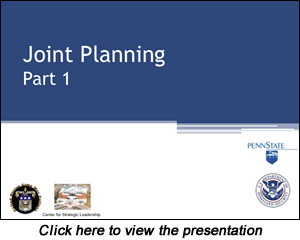
Joint Planning Presentation - Part 1
This presentation is from the corresponding course, Strategic Planning and Organizational Imperatives in Homeland Defense and Security, at the Naval Postgraduate School Center for Homeland Defense and Security (CHDS). It covers a lot of ground and is worth reviewing. This presentation is admittedly rather long and I my intention is not to inflict “DBPP”…death by power point. Again, there is a great deal of worthwhile information, so, please bear with me on this one. Because it is a rather lengthy presentation, I broke it into two parts.
On Slides 3 and 4, the presentation will initially give you a brief overview of strategy formulation. I also want to draw your attention to Slide 7, “Translating National Guidance Into DOD HD Strategy.” We will revisit this in Module 3, DOD’s Role in Homeland Defense. Additionally, this presentation refers to several national-level documents that we will not specifically read or cover in the course. (For example, the National Planning Scenarios, the National Preparedness Goal, the Universal Task List, and the Nationwide Plan Review.) But the presentation addresses some of the issues associated with these documents and I would recommend reading them at some point in the future at your convenience. Click the image to view the presentation.
Acknowledgements: Bert Tussing, Greg Moser, Bob Bach, and Cliff Nancarrow.